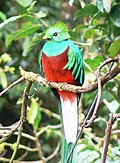This article needs additional citations for verification .(July 2023) |
| Pharomachrus | |
|---|---|
 | |
| Resplendent quetzal | |
| Scientific classification | |
| Kingdom: | Animalia |
| Phylum: | Chordata |
| Class: | Aves |
| Order: | Trogoniformes |
| Family: | Trogonidae |
| Genus: | Pharomachrus de la Llave, 1832 |
| Type species | |
| Pharomachrus mocinno [1] de la Llave, 1832 | |
| Species | |
P. antisianus | |
Pharomachrus is a genus of birds in the family Trogonidae.
The five species of this genus and the eared quetzal, the only living member of the genus Euptilotis, together make up a group of colourful birds called quetzals.












